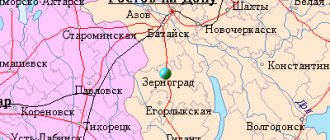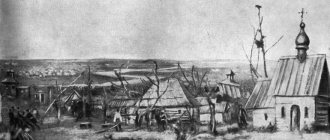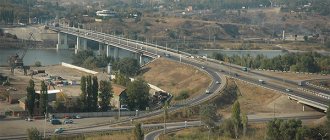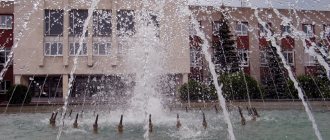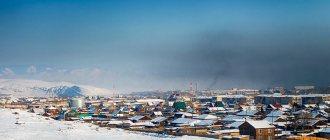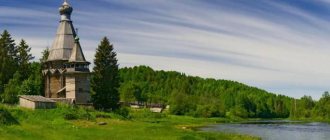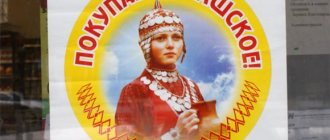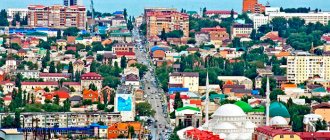Belaya Kalitva was founded in 1703, and the first mentions of it are associated with the times of “The Tale of Igor’s Campaign,” when the Russian army was killed in the battle with the Polovtsians. Archaeological excavations say that people lived here in the 2nd millennium BC. The city itself is quite green and clean, and makes a pleasant impression. The only thing was that it was difficult to navigate the road, since the city has an irregular shape and is divided by rivers; we got lost several times and went to the wrong place. Belaya Kalitva is located in the center of the Rostov region and is the cradle of the Don Cossacks.
The route of our trip and its concept can be seen here: We are participating in the project “Russia in 365 days”
The surroundings of Belaya Kalitva are very picturesque: hills, rocky Avila Mountains, and the wide Seversky Donets River flows through it. We rarely visit the steppe, but we got the impression that the Belokalitvensky region has a landscape uncharacteristic for the steppes. Despite our love for dense forests, we often couldn't take our eyes off one or another spectacular view.
Belaya Kalitva Rostov region
You can see Belaya Kalitva in one day, and its surroundings in a couple more. For the first time this will be enough. First, it is best to go to the Museum of Local Lore and get acquainted with the main historical moments, then take a walk through the city park located not far from the museum, then climb Karaul Mountain and look at the whole city from above.
On Maidan Square
Novovvedensky Cathedral
Father has been with us for 20 years
The book The Lay of Igor's Campaign in the museum
Belaya Kalitva Museum of History and Local Lore
Belaya Kalitva Museum of History and Local Lore
Belaya Kalitva Museum of History and Local Lore
Belaya Kalitva Museum of History and Local Lore
Inscriptions in the city park
Old cart in a city park
Coat of arms of the city of Belaya Kalitva
A new tradition for newlyweds to hang locks
Monument in the city park
One of the problems of the city is the lack of toilets
Belaya Kalitva on the map of Russia: geography, nature and climate
Belaya Kalitva is located on the eastern outskirts of the Donetsk Ridge the Seversky Donets River , the largest tributary of the Don , flows through it . rivers Likhaya and Kalitva flow into it .
The city is located in the steppe zone. Due to its southern location, Belaya Kalitva has a fairly warm climate. In winter, temperatures remain mostly below zero, but thaws often occur.
The summer season is characterized by hot weather and plenty of sun; maximum precipitation occurs in December and January, with a minimum in August.
Karaul Mountain
Karaul Mountain is closely connected with the Tale of Igor's Campaign. In 1970, a monument to brave Russians was erected. Previously, a reconstruction of the battle and Kayal readings took place here (then they were moved).
View from Karaul Mountain to the city of Belaya Kalitva
View from Karaul Mountain to the city of Belaya Kalitva
Behind the houses is the goal of the Avila Mountains
People of Belaya Kalitva
First of all, Belaya Kalitva will be of interest to history buffs; this is its main attraction. What happened here: genocide against the Cossacks, numerous territorial transformations, occupation and prisoner of war camps, battles for liberation. At the same time, judging by historical information, there is a large percentage of people here who have done something outstanding: 19 heroes of the USSR during the Great Patriotic War, 3 holders of the Order of Glory, 29 laureates of State Prizes, 7 world champions, dozens of champions of Russia and Europe. But this is just a town of miners and metallurgists. There is probably something special about these lands...
I wrote about some people living now, who do not complain about their bad life and are gradually changing the world in this article - Belaya Kalitva and people who love their city.
Belaya Kalitva, city
October 10, 2021
2
Belaya Kalitva is a city, the administrative center of the Belokalitvinsky district of the Rostov region.
coat of arms Belaya Kalitva
From the history:
In 1941, the village of Ust-Belokalitvinskaya began to be called the village of Belaya Kalitva, in 1958 the village received the status of a city, and in 1959 - a regional center. Since 1988, the city and the Belokalitvinsky district (76 settlements) have been a single territorial unit with a common administrative control. The city and district are located in the central part of the Rostov region, on the eastern tip of the Donetsk Ridge, on the banks of the largest tributary of the Don - the Seversky Donets. The city itself stands at the mouth of the Kalitva and Likhaya rivers flowing into the Donets. There are a total of 6 rivers, 8 rivulets, and 20 streams in the area. The right rocky bank of the Seversky Donets in the vicinity of the city has a highest elevation of 148.8 m above sea level. Territory area 2650 sq. km, length from north to south is 150 km. The population as of January 1, 2003 was 113.7 thousand people, of which 82.1 thousand were urban residents, 31.6 were rural residents.
The length of the North Caucasian Railway across the territory is 95 km with the stations “Boguraevo”, “Belaya Kalitva”, “Grachi”. The city bus station, located on the Rostov-Volgograd highway, serves 20 intercity routes and 39 transit routes, including those to Ukraine. Summer intercity routes along the Donets have been cancelled, only local ones operate. The local airline airport serves agricultural aviation.
Belaya Kalitva
Belaya Kalitva was founded in 1703, and the first mentions of it are associated with the times of “The Tale of Igor’s Campaign,” when the Russian army was killed in the battle with the Polovtsians. Archaeological excavations say that people lived here in the 2nd millennium BC. Belaya Kalitva is located in the center of the Rostov region and is the cradle of the Don Cossacks.
In 1703, a group of Cossacks petitioned military chieftain Ekim Filipyev for permission to settle a new town at the mouth of the Belaya Kalitva River. This date is considered official, although back in 1515, the ambassador of Vasily III Korobov, in his report, mentioned the people he saw at the mouth of the Kalitva. The embassy's route passed along one of the oldest caravan routes through the rifts of the Donets, which shallowed in summer. Excavations in 2002 (Don Archaeological Society, R.V. Prokofiev) indicate that there was an ancient Russian settlement on the territory of the 12-13th century. In 1675 -1683, Old Believers settled in the area, away from the caravan routes.
The entire pre-revolutionary history of Belaya Kalitva is connected with the Cossacks. Among the outstanding military leaders of Belokalitvintsy, Pyotr Ivanovich Pavlov is famous. For the brilliantly organized fortifications in the defense of Sevastopol in 1855, Alexander III personally awarded him the Order of St. Anna 1st degree. During the same war, Colonel Ivan Ivanovich Kostin became famous for his bravery. Major General Viktor Danilovich Popov graduated from service as manager of the Ataman's office. Lieutenant General Nikolai Ivanovich Lazarev distinguished himself in the Russian-Turkish War of 1877 -1878, was awarded gold and silver weapons, and a number of Russian and foreign orders.
Since 1804, stone mining (sandstone, limestone) began in Ust-Belokalitvinskaya; 1827 - coal.
The beginning of near-political activities in the Ust-Belokalitvinsk mining villages was laid by E.A. Shchadenko and S.S. Turlo.
In May 1918, the headquarters of the 5th and 3rd Ukrainian Red Armies retreating to Tsaritsyn under the command of K.E. was located in Ust-Belokalitvinskaya for several days. Voroshilov. The historic meeting of the Red Army commanders N.A. took place here. Rudneva, A.Ya. Parkhomenko, E.A. Shchadenko and Artem. At the same time, the expedition of F.G. arrived in the village. Podtelkova and M.V. Krivoshlykova.
During the Great Patriotic War, Cossack valor made itself felt: three Belokalitvinians became full holders of the Order of Soldier's Glory, fifteen became Heroes of the Soviet Union.
Belaya Kalitva was under German occupation for six months. Her liberation took place in the area of the Battle of Stalingrad.
In the Belaya Kalitva region there are active Orthodox churches: one from the 18th century (rebuilt) and three from the 19th century. Two churches are being restored and two new ones are being built. On one of the hills located within the city, in 1970, the only monument in Russia to “The Tale of Igor’s Campaign” was erected. There is a municipal historical and local history museum.
The cultural life of the city and region is represented by three music schools and an art school with branches, 44 libraries and 43 club institutions, 195 amateur art groups. Since the work of the famous folklorist, our fellow countryman Professor AM Listopadov (1873-1949), ancient songs have continued to be collected here. A developed sports complex: a Sports Palace with two swimming pools, 98 gyms, two rowing bases, a chess club, four sports schools, including the Olympic reserve.
Five world champions in kayaking and canoeing, a world champion in athletics, dozens of European and Russian champions.
More than 300 Belaya Kalitva residents were awarded the titles Honorary and Honored by professional affiliation.
40 doctors and candidates of science, famous writers, singers, actors, directors, musicians came from Belaya Kalitva.
The city-forming enterprise is the metallurgical enterprise, currently CJSC Alcoa Metallurg Rus, founded in 1941. In 1969, the plant was the first in the world to master the casting of ingots into an electromagnetic crystallizer (the invention was patented in 17 countries around the world). The specialists became laureates of the USSR State Prize. The plant was the first in the USSR to master the production of Teflon-coated cookware. Participated in projects for the construction of the Ruslan aircraft and the Buran spacecraft, and received the 1997 Government Prize No. 1 in the field of quality.
Protected historical and cultural sites of the city:
- 1. Cossack gymnasium in the city of Belaya Kalitva, area of the motor town;
- 2. Novovvedensky Cathedral on the Maidan in Belaya Kalitva;
- 3. A shop and a residential building that belonged to the merchant Sevryugov are located on the Maidan in the city of Belaya Kalitva;
- 4. The house that belonged to the merchant Suichmedov, where the Don writer A. Suichmezov was born, is located on the Maidan;
- 5. Ataman’s office, located on the Maidan;
- 6. Alley of War and Labor Heroes and Internationalist Soldiers in Mayakovsky Park
At the entrance to Belaya Kalitva in 2005, a Cossack Orthodox cross with a horse was installed. In the old days, Cossacks, leaving the city on a campaign, stopped in front of the same cross and signed themselves with the banner of the cross. And returning home, they thanked God.
The Orthodox cross and the Cossack horse with a bowed head are made of iron reinforcement and concrete, painted on top. The cross rises 9 meters above the ground and is buried 2 meters into the ground. Its weight reaches 10 tons, and the weight of the horse is 3 tons.
Famous personalities:
- Ataev Annaklych, Hero of the Soviet Union, Hero of Turkmenistan
- Zagortsev Andrey Vladimirovich, writer
- Chicherova Anna Vladimirovna, famous athlete (high jumper)
Cossack cross
Cossack Cadet Corps
On the topic of people and the new generation... In Belaya Kalitva there is a prestigious Cossack cadet corps, where children not only from the Rostov region, but also from the Krasnodar Territory, Moscow and Siberia come to study. Unfortunately, the school was undergoing renovations, and we just walked around the empty rooms.
Cadets don't smoke
Patriotic inscription in the cadet corps
This poster is full of Cossack girls.
Igor tries himself as a cadet


